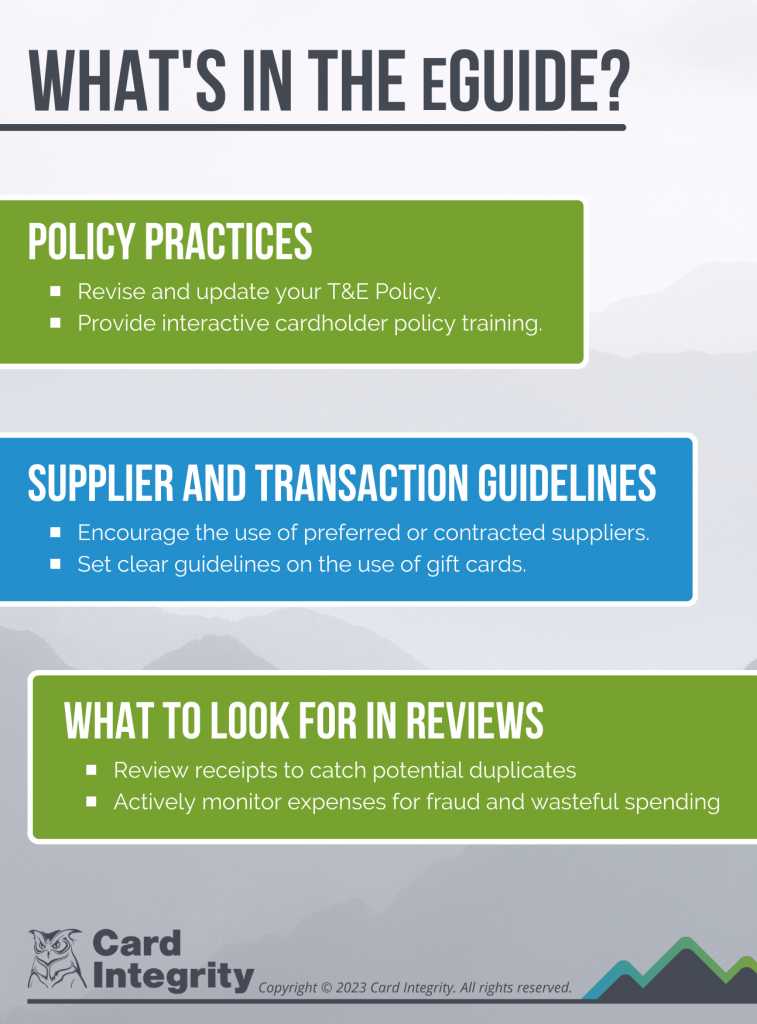Having a reliable corporate travel policy in place is essential for organizations of all sizes. Travel and Entertainment (T&E) expense programs allow companies to manage expenses incurred by employees who are traveling for business purposes or entertaining business relationships.
While T&E expenses can range from money spent on lodging, transportation, and meals, monitoring these costs can raise challenges for finance managers. Some of these challenges include excessive costs for travel and limited spend visibility which can make these expenses even more difficult to audit.
Here are four key corporate travel policy challenges to identify as well as strategic tips to overcome these challenges.
T&E Dining
When employees travel to a professional event or a business client comes to town, cardholders should be using their T&E cards to cover meals and drinks. That said, it’s very easy to go overboard, so the key is determining reasonable limits around food and drink spending.
Some corporate travel policy best practices include setting a daily limit that employees can spend on food and drink when traveling and requiring that they submit an itemized receipt. Also, clearly define what travel-related meals would include such as food purchased for a trip longer than 24 hours that includes an overnight stay.
Realize that when you set clear meal spending guidelines for traveling, this may be different from local dining spending policies. Local dining may have a more strict per diem rate since it’s likely easier to estimate food costs in the area.
Then, there are business meetings such as lunches and dinners to include. Communicate with employees that while they can entertain colleagues and clients at a local restaurant for dinner, they don’t have to necessarily “wine and dine” their guests with excessively elaborate purchases.
Extra Travel Benefits
Travel can already get expensive, but Finance Managers and auditors will want to make sure cardholders are not spending excess company funds on their travel cards. Additional costs could creep in from airport travel clubs and lounges to first-class tickets and additional travel services that may not be addressed in the corporate travel policy.
Using a third-party commercial card expense monitoring service can help auditors narrow down off-policy spending and expose red flags. It’s important to catch additional non-compliant travel spending early. Sometimes, employees don’t realize they are violating policy rules. Other times, a cardholder may be tempted to test the limits and see if certain extra spending will be recognized and addressed.
Either way, a clear and updated corporate travel policy can help Finance Managers and employees get on the same page to limit wasteful and unnecessary travel spending.
Preferred Supplier Sourcing
Travel card spending from your Travel and Entertainment Program offers opportunities for sourcing deals with preferred suppliers of common travel expenses. Some of these preferred suppliers include specific airlines, hotels, and vehicle rental services.
It’s crucial that employees utilize preferred suppliers for their T&E spending in order to support these relationships and also for cost savings. Your suppliers may offer certain discounts on purchases which can come in handy for travel spending.
Oftentimes, a cardholder’s failure to use a preferred supplier is due to lack of communication. Be sure to avoid this by sharing supplier sourcing details in your card policy. Explain how to use the suppliers and how it benefits the organization when employees stick with approved suppliers.
Periodic cardholder training can also be helpful to equip employees to handle case-by-case situations which can also make the expense review process run smoother.
Limited Spend Behavior Visibility
Travel card transactions can be difficult to approve when the time comes to audit your travel and entertainment program expenses. One common case of issues that can be difficult to monitor includes double dipping.
For example, double dipping can occur when someone takes a coworker out for a meal while traveling. Perhaps the coworker didn’t use their T&E card for the meal and could still technically have money to spend within a set limit despite consuming X dollars worth of food on someone else’s card.
Another instance may be added costs from people outside of the organization. Let’s say an employee decides to take a family member out to eat and uses the company card to pay for it. An audit likely won’t catch excess costs from bringing people such as family members or friends to meals or hotels unless the cardholder willingly comes forward or a spend limit is exceeded.
While setting purchase limits is a great start, you will also need to strengthen other internal controls to increase spend behavior visibility. That way, you can keep tabs on activity in real-time with tools such as an expense monitoring service. Card Integrity’s expense monitoring quickly assesses 250 spend behaviors and organizes spend data into specific categories so it’s easier to analyze.
Overcome Corporate Travel Policy Challenges with the Right Practices
Running a T&E program can be an effective way to manage business travel expenses and maintain a budget so long as you focus on implementing the best practices. This includes utilizing the right tools and having a detailed policy. Card Integrity can assist with monitoring your expenses to help finance teams better enforce the card policy, strengthen relationships with suppliers, and achieve cost savings.
Our flagship service, DataWise, reviews 100% of your organization’s transactions across various payment methods for monitoring supplier usage, non-compliant behavior, and more.
Receive monthly reports and speak with your very own forensic specialist, who can explain key findings and customize the data report to highlight any specific areas you wish to focus on.
These solutions can go a long way in helping organizations overcome the common challenges faced when dealing with T&E Cards. To get more tips and advice on managing your Travel Card expenses, download the Card Integrity T&E Best Practices eGuide.




